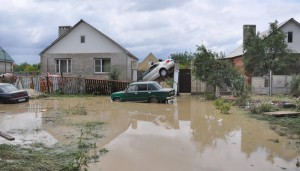Did you know that everyone lives in a flood zone? It’s just that every area has a different level of risk, low, moderate, or high. It’s common to think floods only happen on the coasts. However, millions of flood insurance claims have come from states with no coastal land. So, are you at risk?
You could be. Surprisingly more than 20 percent of flood insurance claims come from those living in moderate-to-low risk areas, according to the National Flood Insurance Program. This tells us that although you may think you’re safe from floods, you may not be.
If you do experience a flood, your basic homeowners insurance won’t cover it. Because of this, you need to determine if flood insurance is the right thing for you. To help you decide, let’s explore floods and risk areas and learn how to determine your risk.
What Qualifies as a Flood?
A flood occurs when two or more houses or two or more acres of land that are normally dry become overtaken by water or mudflow. A number of things can cause a flood, including:
- Rapid rainfall accumulation
- Tropical storms
- Failure of or flooding over a levee
- Rapid snow melt
- Ice jams
- Clogged drainage systems
Do I Need Flood Insurance in My Area?
Although flooding can happen anywhere, different areas have different risks. The Federal Emergency Management Agency (FEMA) has created flood maps known as FIRMS (Flood Insurance Rate Maps) that help us understand the flood risk to individual areas. The maps are based on topography, climate, development and flooding history.
Studying the maps and knowing if your area is high risk, moderate-to-low risk, or undetermined risk can help you decide whether you need flood insurance.
- High-risk Areas: These are often known as special flood hazard areas (SFHA). If you live in a high-risk area, you have 1 in 4 chance of facing a flood during your 30-year mortgage. Remember, your homeowners insurance won’t cover a flood. If you have a mortgage that is federally regulated or from an insured lender, and you live in a high-risk area, you are required to carry separate flood insurance.
- Moderate-to-low Risk Areas: In these areas your risk for being hit by a flood is reduced, but still exists. Therefore, flood insurance is still recommended. It’s easy to see why: one-third of disaster assistance goes to those living in moderate-to-low risk areas.
- Undetermined-risk Areas: Although there is still a risk of floods in these areas, no analysis has been conducted to determine the risk. Less populated areas often are undetermined risk areas. If you live in one of these areas, it’s still important to carefully assess your need for flood insurance.
How Can I Determine My Risk?
Now that you know the different risk categories, it’s time to determine your risk. The National Flood Insurance Program is a great place to start. It’s where you can look at the flood insurance rate maps and also fill out a flood risk profile to determine the risk level for your property.
Flood Insurance May Be Worth It in Richmond, Virginia
All 50 states can have floods and flash floods. The risk of you being affected by a flood depends on where you live. Because your homeowners insurance doesn’t cover floods, it’s a risk you should know.
As you’re determining your flood risk and need for flood insurance, The Andrew Agency is here to walk you through each step. With our expertise and knowledge we can help you determine your risk of financial loss should a flood occur. Contact us today to discuss your risk and if flood insurance is right for you. Call Ryan Andrew at (804) 320-2886.











